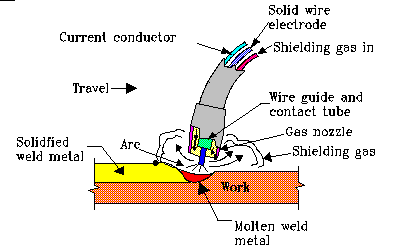|
MIG Welding Shielding Gas Basics
MIG (GMAW) welding with shielding gas and a solid wire electrode produces a clean, slag-free weld without the need to continually stop welding to replace the electrode, as in Stick welding. Increased productivity and reduced clean up are just two of the benefits possible with this process.
To achieve these results in your specific application, however, it helps to understand the role of shielding gas, the different shielding gases available and their unique properties.
The primary purpose of shielding gas is to prevent exposure of the molten weld pool to oxygen, nitrogen and hydrogen contained in the air atmosphere. The reaction of these elements with the weld pool can create a variety of problems, including porosity (holes within the weld bead) and excessive spatter.
Different shielding gases also play an important role in determining weld penetration profiles, arc stability, mechanical properties of the finished weld, the transfer process you use and more.
Choosing MIG gun consumables that provide consistent and smooth shielding gas delivery are also important to making successful MIG welds.
Choosing The Right Gas
br
Many MIG welding applications lend themselves to a variety of shielding gas choices, and you need to evaluate your welding goals in order to choose the correct one for your specific application. The cost of the gas, finished weld properties, preparation and post-weld clean up, the base material, weld transfer process and your productivity goals all need to be taken into account when selecting a shielding gas.
Argon, Helium, Carbon Dioxide and Oxygen are the four most common shielding gases used in MIG welding, with each providing unique benefits and drawbacks in any given application.
Carbon Dioxide (CO2) is the most common of the reactive gases used in MIG welding and the only one that can be used in its pure form without the addition of an inert gas. CO2 is also the least expensive of the common shielding gases, making an attractive choice when material costs are the main priority. Pure CO2 provides very deep weld penetration, which is useful for welding thick material; however, it also produces a less stable arc and more spatter than when it is mixed with other gases. It is also limited to only the short circuit process.
For many companies, including those that place an emphasis on weld quality, appearance and reducing post-weld clean up, a mixture of between 75 ? 95 percent Argon and 5 ? 25 percent CO2 will provide a more desirablecombination of arc stability, puddle control and reduced spatter than pure CO2. This mixture also allows the use of a spray transfer process, which can produce higher productivity rates and more visually appealing welds. Argon also produces a narrower penetration profile, which is useful for fillet and butt welds. If you’re welding a non-ferrous metal ? aluminum, magnesium or titanium ? you’ll need to use 100 percent Argon.
Oxygen, also a reactive gas, is typically used in rations of nine percent or less to improve weld pool fluidity, penetration and arc stability in mild carbon, low alloy and stainless steel. It does cause oxidation of the weld metal, however, so it is not recommended for use with aluminum, magnesium, copper or other exotic metals.
Helium, like pure Argon, is generally used with non-ferrous metals, but also with stainless steels. Because it produces a wide, deep penetration profile, Helium works well with thick materials, and is usually used in ratios between 25 ? 75 percent Helium to 75 ? 25 percent Argon. Adjusting these ratios will change the penetration, bead profile and travel speed. Helium creates a ‘hotter’ arc, which allows for faster travel speeds and higher productivity rates. However, it is more expensive and requires a higher flow rate than Argon, so you’ll need to calculate the value of the productivity increase against the increased cost of the gas. With stainless steels, Helium is typically used in a tri-mix formula of Argon and CO2.
Getting the Gas to the Weld Pool
All of your efforts selecting the right shielding gas will be wasted, however, if your equipment isn’t getting the gas to the weld. The MIG gun consumables, consisting of a diffuser, contact tip and nozzle, play a crucial role in ensuringthat the weld pool is properly protected from the air atmosphere.
If you choose a nozzle that is too narrow for the application or if the diffuser becomes clogged with spatter, for example, there might be too little shielding gas getting to the weld pool. Likewise, a poorly designed diffuser might not channel the shielding gas properly, resulting in turbulent, unbalanced gas flow. Both scenarios can allow pockets of air into the shielding gas and lead to excessive spatter, porosity and weld contamination.
When selecting MIG gun consumables, choose ones that resist spatter build up and provide a wide enough nozzle bore to ensure adequate shielding gas coverage. Some companies offer nozzles with a built in spatter guard that also adds a second phase of shielding gas diffusion, resulting in even smoother, more consistent shielding gas flow.
Choosing the right shielding gas for your specific application will require a careful analysis of the type of welding you are doing as well as your operational priorities. Using the guidelines above should provide a good start to the learning process, but be sure to consult your local welding supply distributor prior to making a final decision.
|

